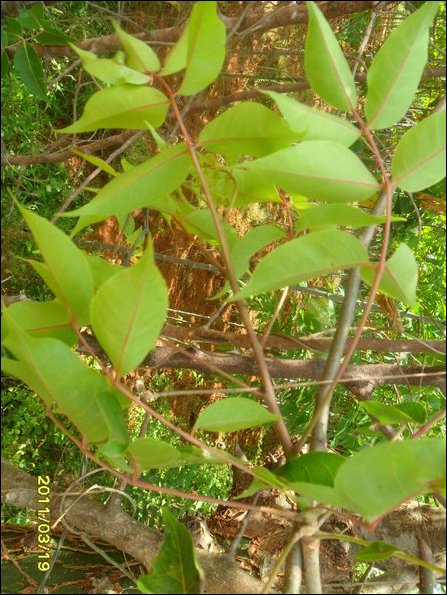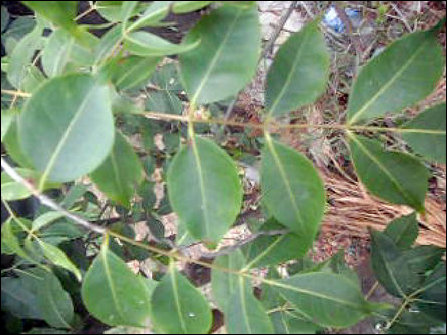Know the Etymology: 197
Place Name of the Day: Thursday, 14 December 2017
Kiḷuvai-nāṭṭi, Kaṉṉāṭṭi, Kal-nāṭṭiṉa-kuḷam, Kannaṭṭiya
கிளுவைநாட்டி, கன்னாட்டி, கல்நாட்டினகுளம், கன்னட்டிய
Kiḷuvai-nāṭṭi, Kaṉṉāṭṭi, Kal-nāṭṭiṉa-kuḷam, KannaṭṭiyaKiḷuvai+nāṭṭi
Kal+nāṭṭi
Kal+nāṭṭi+kuḷam
Kal+naṭṭiya
The place where Kiḷuvai trees are planted (to mark the boundary)
The place demarcated by stones erected (to mark the boundary)
The tank of the place in where the boundaries are set by erecting border stones; or the tank where a stone pillar or post has been set
The place demarcated by stones erected (to mark the boundary)
| Nāṭṭi | a place that has been planted with trees or erected with posts, usually to mark the boundaries (Eezham Tamil place names); either a noun form now obsolete in Eezham Tamil usage, or a suffix-lost ending coming from the verb Nāṭṭu: (verb) to set up, fix, plant, place in the ground, erect; (noun) position, posture (Tamil, DED 3583); Nāṭṭi: past tense verbal form of Nāṭṭu, coming in the context of a boundary set, as in "Kalluṅ kaḷḷiyum nāṭṭi (Tamil, inscription, 550 CE, TASSI, 1958-59, p. 41-83; p. 26-32); Nāṭṭi, Nāṭṭa: (noun) post (Malayalam, DED 3583); Nāṭa: a pole used for a hedge (Tulu, DED 3583); Neḍige: a post or pillar fixed in the ground (Kannada, DED 3583); Naṭu: (verb) to set up as a pillar, post or mast, to plant, set (Tamil, DED 3583); cognates in 9 Dravidian languages; Naṭu-kal: memorial stone (Tamil, DED 3583, Akanāṉūṟu, 53: 10-11); Kaṉṉāṭu: Kal+nāṭu: memorial stone (Tamil, inscription, 715 CE, EI, vii, 4.i; note the form Nāṭu) |
| Nāṭṭiṉa | where something has been planted or erected; adjectival form of Nāṭṭu (see box on Nāṭṭi) |
| Kannaṭṭiya | Sinhalicised form of Kaṉṉāṭṭi found in North Central Province (Kal+nāṭṭi) |
| Kiḷuvai | a tree planted to make live fences especially in Jaffna, of which there are two kinds, Muṭ-kiḷuvai and Pāl-kiḷuvai (Eezham Tamil); Indian balm of gilead, Balsamodendron berryi; hill balsam tree, Balsamodeddron caudatum (Tamil, DED 1587); Kiḷivā: Madras balsam tree, Balsamodendron berryi (Malayalam, DED 1587); Muṭ-kiḷuvai: the thorny variety of Kiḷuvai that is commonly used for live fences, Indian balm of gilead, Basamodendron berryi (Tamil, MTL); Kiḷuvaik-katiyāl: the Kiḷuvai tree used as live-fence post (Eezham Tamil usage; Katiyāl: Kati+kāl; literally meaning the straight and high post, or the grow-big post, DED 1191+1479) |
| Kal | stone, stone pillar, post or boundary stone in the context of the place names (Tamil, DED 1298, see column 24) |
The suffix Nāṭṭi coming in a few Eezham Tamil place names, along with prefixes like Kal, Kiḷuvai etc., means a place demarcated by setting boundary stones, posts etc., or by planting trees.
Nāṭṭi corresponds to the verbs Nāṭṭu and Naṭu in Tamil/ Dravidian, meaning to plant or erect. But the word-form Nāṭṭi as a noun ending is not found in current Tamil usage. It may be a suffix-lost ending, such as Kaṉṉāṭṭik-kuḷam becoming Kaṉṉāṭṭi, or it may be a forgotten Eezham Tamil usage corresponding to the noun usage of Nāṭṭi in Malayalam. In Malayalam, Nāṭṭi is a noun and it means a post. Also note that in Tamil inscriptional usage such as Kaṉṉāṭu, the word-form Nātụ coming from the verb Naṭu, is a noun, meaning a memorial stone erected.
* * *The verbal usage of Nāṭṭi in the context of setting boundary:"கல்லுங் கள்ளியுந் நாட்டி" (Tamil inscription, c. 550 CE, TASSI, 1958-58, p. 41-83; p. 26-32)
"Kalluṅ kaḷḷiyun nāṭṭi" (Tamil inscription, c. 550 CE, TASSI, 1958-58, p. 41-83; p. 26-32)
Setting stone and planting milk hedge (to mark the boundary)
The usage of Naṭu in the context of erecting memorial stone:"வீழ்ந்தோர் எழுத்துடை நடு கல்" (அகநானூறு, 53: 10-11)
"Vīḻntōr eḻuttuṭai naṭu kal" (Akanāṉūṟu, 53: 10-11)
The inscribed stones erected in the memory of those who have perished
Kaṉṉāṭu as a noun meaning a stone erected in memory:"சோழிகர் எறிந்து பட்டாரிது கன்னாடு" (Tamil inscription, 715 CE, EI, vii, 4.i)
"Cōḻikar eṟintu paṭṭāritu kaṉṉāṭu" (Tamil inscription, 715 CE, EI, vii, 4.i)
The erected stone in the memory of the one who died in fighting the Coḻikar
* * *Kiḷuvai-nāṭṭi is a locality in Mātakal West, in Valikamam Southwest division of Jaffna district.
Kaṉṉāṭṭi comes as a place name in Manthai West division of Mannar district; Venkalachcheddikulam division of Vavuniya district and in Nanaddan division of Mannar district. The last one is often written as Kalnāṭṭi.
Kal-nāṭṭiṉa-kuḷam is a tank name and place name found near Īṟaṟperiyakuḷam in Vavuniya South division of Vavuniya district.
Kaṉṉāṭṭiya is a place name found in Mihinthale division of Anuradhapura district.
* * *Some related place names:Kaṉṉāṭṭi:Malli-kaṉṉāṭṭi: Nanaddan, Mannar (Mantai OIS). In official records the name is sometimes written as Mallikai-nāṭṭi
Karaiyāṉ-kaṉṉāṭṭi: near Mūṇṭāmmpiṭṭi, Veḷḷāṅkuḷam, Manthai West, Mannar (Tunukkai OIS). Karaiyāṉ: a man of the Karaiyār community
Maṟatti-kaṉṉāṭṭi: near Neṭuṅkaṇṭal and Aṭampaṉ, Manthai West, Mannar (Mantai OIS). Maratti: a woman of the Maṟavar community
Kaṉṉāṭṭik-kallu: near Cuvantamuṟippu, a place having ruins and a temple, Kokkuttoṭuvāy, Karaituraippattu, Mullaiththevu (Kokkilai OIS)
* * *Notes on Kiḷuvai:
The species of Muṭ-kiḷuvai, found in the island especially in the Jaffna peninsula, has long straight branches. The branches are cut and planted to make new fences. The fence trees are allowed to branch only at a required height and then the branches are cut annually to maintain the fence at that height.
The thorny stems of Muṭ-Kiḷuvai make it effective for fences. While the trees alone make a fence, often palmyra leaves or coconut palm cadjans are tied on the trees to make screened fences.
The leaves provide fodder. The shoots on the stems of matured trees have triple leaves. The Muṭ-kiḷuvai leaves can be used in the worship of Siva as a substitute for Vilvam leaves. The Saiva priests of Jaffna who officiate death and death anniversary rituals use the leaves of Muṭ-kiḷuvai, Kārai, wood apple etc., if Vilvam is not available.
Muṭ-kiḷuvai bark, leaves and the milky juice that comes out when the leaves are plucked off have a strong aroma. The tree produces a resin that has a very high content of gum.
Muṭ-kiḷuvai fences, similar to the pole or post type found in Jaffna, could also be seen in the Nākappaṭṭiṉam district of Tamil Nadu. Other types of live fences made of Muṭ-kiḷuvai are seen in South India.
The people of the Paliyan tribe of the Paḻani Hills of Tamil Nadu, who make fences by the Kiḷuvai tree, also know the technique of making fire from the sticks of the tree (Wild Forest Making Sense With People, Finland, p 29).
* * *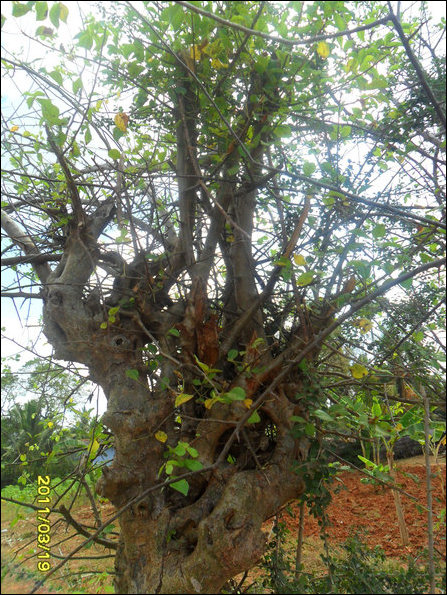
A Matured Mud-kiluvai (Balsamodendron berryi) tree that was once probably part of a fence, photographed in Jaffna. Note the result of cutting branches at a particular height for several years
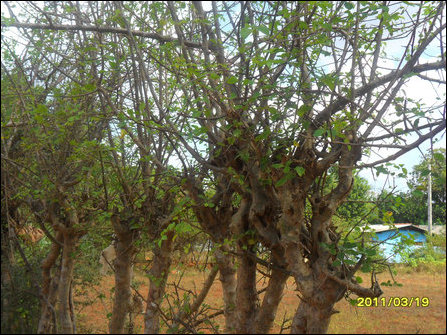
A line of old Mud-kiluvai (Balsamodendron berryi) trees at an abandoned fence, photographed in Jaffna
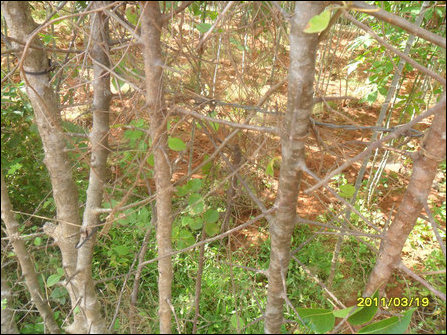
Note the effectiveness of the thorns and side branches of a Mud-kiluvai (Balsamodendron berryi) fence of a garden plot, photographed in Jaffna
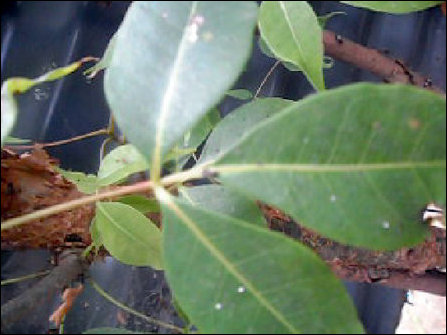
Leaves of Mud-Kiluvai (Balsamodendron berryi). From matured stems appear the three-leaves shoots.
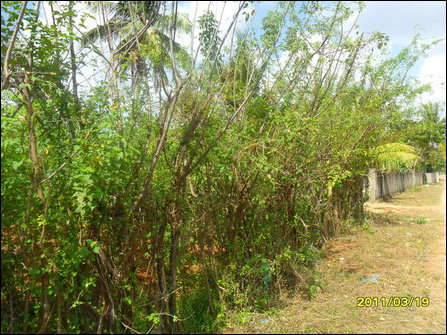
A fence of Mud-kiluvai (Balsamodendron berryi) trees photographed in Jaffna. Note the straight long branches at a particular height, which will be cut at that level every year or once in two years.
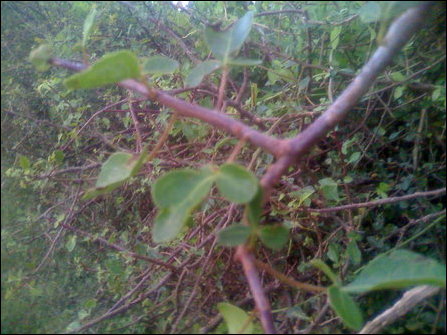
Another species of Mud-kiluvai found in Tamil Nadu, photographed in Vadavedampatti, Coimbatore district [Image courtesy: Rajeshkumar, webcache.googleusercontent.com]
Previous columns:










